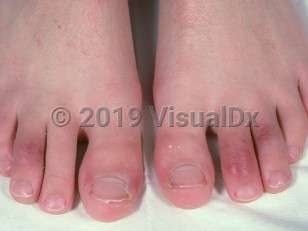Chilblains in Adult
Alerts and Notices
Important News & Links
Synopsis

Chilblains, also known as pernio, is characterized as erythematous / violaceous papules that present after exposure to a cold and wet environment. It is typically observed during the fall and winter in seasonal climates. Lesions usually appear over a few hours and resolve over 7-14 days. They are initially pruritic and sometimes painful. (See COVID-19 for discussion of "COVID toes.")
Chilblains is most common in children and young to middle-aged women. Lesions are typically self-limited but may be recurrent. Chronic pernio is characterized by persistent lesions after repeated exposure to the cold. Blistering, pustules, crusting, and ulceration can occur in severe cases. Chilblains results from an abnormal inflammatory and vascular response to cold temperatures, especially when the environment is also humid.
Equestrian perniosis is a rare variant that usually affects the thighs and buttocks of (most often female) horseback riders. It may affect individuals in other recreational scenarios involving cold exposure and tight-fitting clothing, such as motorcycle riders or outdoor enthusiasts. Histology is generally consistent with that of classic perniosis.
Pernio can be a primary disorder or secondary to other conditions, such as connective tissue disease, monoclonal gammopathy, cryoproteinemia, chronic myelomonocytic leukemia, and viral infections, although the causative mechanisms have yet to be established. Compared with primary pernio, secondary pernio tends to be associated with photosensitivity and persistence beyond cold seasons.
Chilblains is most common in children and young to middle-aged women. Lesions are typically self-limited but may be recurrent. Chronic pernio is characterized by persistent lesions after repeated exposure to the cold. Blistering, pustules, crusting, and ulceration can occur in severe cases. Chilblains results from an abnormal inflammatory and vascular response to cold temperatures, especially when the environment is also humid.
Equestrian perniosis is a rare variant that usually affects the thighs and buttocks of (most often female) horseback riders. It may affect individuals in other recreational scenarios involving cold exposure and tight-fitting clothing, such as motorcycle riders or outdoor enthusiasts. Histology is generally consistent with that of classic perniosis.
Pernio can be a primary disorder or secondary to other conditions, such as connective tissue disease, monoclonal gammopathy, cryoproteinemia, chronic myelomonocytic leukemia, and viral infections, although the causative mechanisms have yet to be established. Compared with primary pernio, secondary pernio tends to be associated with photosensitivity and persistence beyond cold seasons.
Codes
ICD10CM:
T69.1XXA – Chilblains, initial encounter
SNOMEDCT:
37869000 – Chilblains
T69.1XXA – Chilblains, initial encounter
SNOMEDCT:
37869000 – Chilblains
Look For
Subscription Required
Diagnostic Pearls
Subscription Required
Differential Diagnosis & Pitfalls

To perform a comparison, select diagnoses from the classic differential
Subscription Required
Best Tests
Subscription Required
Management Pearls
Subscription Required
Therapy
Subscription Required
References
Subscription Required
Last Reviewed:07/11/2019
Last Updated:05/06/2020
Last Updated:05/06/2020
 Patient Information for Chilblains in Adult
Patient Information for Chilblains in Adult
Premium Feature
VisualDx Patient Handouts
Available in the Elite package
- Improve treatment compliance
- Reduce after-hours questions
- Increase patient engagement and satisfaction
- Written in clear, easy-to-understand language. No confusing jargon.
- Available in English and Spanish
- Print out or email directly to your patient
Upgrade Today

Chilblains in Adult

